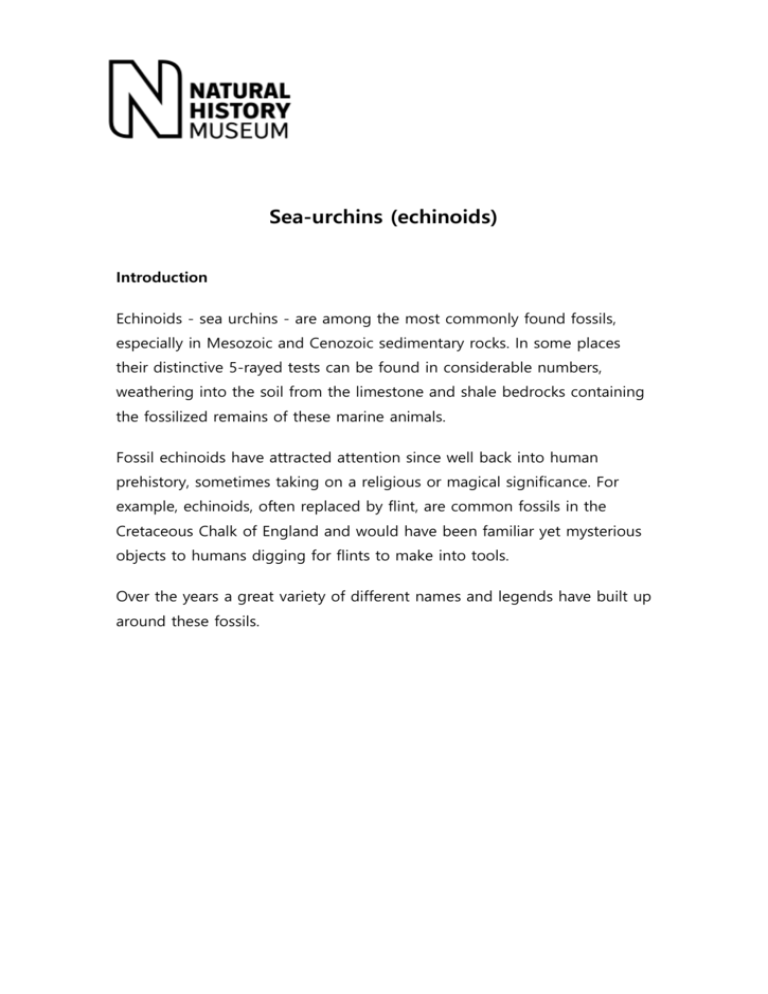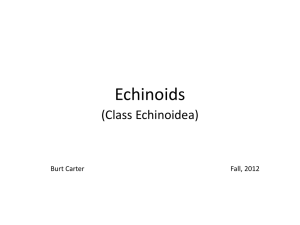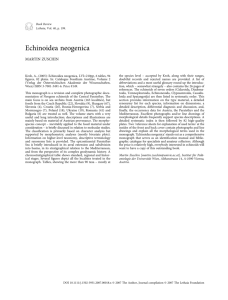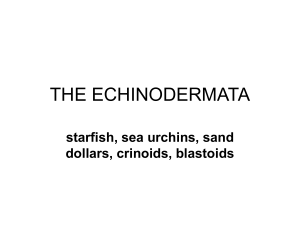Echinoids
advertisement

Sea-urchins (echinoids) Introduction Echinoids - sea urchins - are among the most commonly found fossils, especially in Mesozoic and Cenozoic sedimentary rocks. In some places their distinctive 5-rayed tests can be found in considerable numbers, weathering into the soil from the limestone and shale bedrocks containing the fossilized remains of these marine animals. Fossil echinoids have attracted attention since well back into human prehistory, sometimes taking on a religious or magical significance. For example, echinoids, often replaced by flint, are common fossils in the Cretaceous Chalk of England and would have been familiar yet mysterious objects to humans digging for flints to make into tools. Over the years a great variety of different names and legends have built up around these fossils. Shepherd's crowns Some Cretaceous echinoids, notably Micraster, Echinocorys and Conulus, have distinctive shapes, leading to the name Shepherd's crowns in English folklore. The five rays converging on the apex of the fossil resemble the ribs of a crown. According to Bassett (1982), shepherds may have come across these fossil echinoids, weathered out of the underlying chalk, while caring for their sheep on the downlands of southern England. The echinoid test, and/or the sediment infilling it, can be replaced by flint, making it more resistant than the surrounding soft chalk. This facilitates survival of the fossil once exhumed and increases its chances of being collected. Fairy Loaves - Suffolk An interesting folklore concerning fossil echinoids originates from Suffolk in eastern England. Here, the heart urchin Micraster, along with the helmet urchin Echinocorys , are sometimes known as Fairy Loaves (Evans 1966). The resemblance between these echinoids and round loaves inspired people in north-east Suffolk to place them as charms by the hearth in the hope that the baking bread would be influenced by the fossil's loaf-like shape. It is said that families who kept fairy loaves in their houses could ensure they would always have bread. Failure of the weekly bread to be properly formed was attributed to witchcraft against which Fairy Loaves had protective powers. The powers given to these fossils underlines just how vital bread and breadmaking were to daily life and village economy in Suffolk during times gone past. The fairy loaf in Suffolk was also called pharisee-loaf which at some point became facy-loaf. Farcy is a disease in horses and it has been suggested that the fossils were also used as charms by farm horsemen (Evans 1966). What are echinoids? The Class Echinoidea are marine animals closely related to starfish, sea cucumbers, featherstars, sea lilies and brittle-stars. Together these animals constitute the Phylum Echinodermata, meaning spiny skinned. In echinoids numerous plates make up the skeleton, called the 'test'. This forms a protective casing around the gut and other internal organs. The plates are actually embedded in the 'skin' of the sea urchin. On the outside of the test are tube feet, which help in feeding, movement and respiration, and also articulated spines which act as a defence. Some species of echinoids inhabit rocks on the sea-bed but others burrow down beneath the surface into the sand or mud. Fossil echinoids can be found in rocks back to the Ordovician, up to 450 million years old. However, Palaeozoic species generally had tests with plates that did not interlock and tended to fall apart during fossilization. Younger fossil sea urchins, in contrast, often have intact tests, sometimes even with the associated spines. An estimated 800 species of echinoids are alive at the present day.







